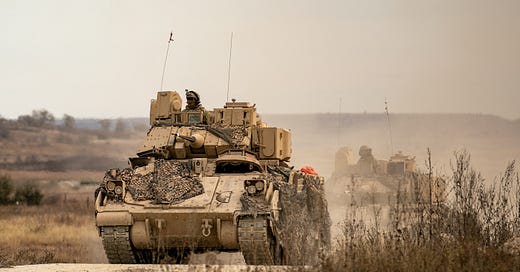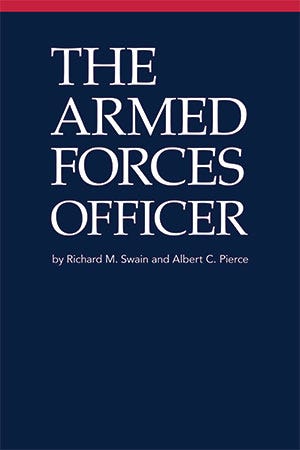Note: Much of what I’ve written thus far and shared with you here has focused on the intersection of social science, philosophy, and, to some extent, theology as they pertain to how we humans navigate the hardship and uncertainty of life. That will continue. Another important part of how we navigate a certain segment of life’s crucibles involves how we conceptualize, operate, and interact with the military. Why? Click here for an explanation. So, I’m exploring that once in a while via a ten-part series unpacking ideas from the book The Armed Forces Officer.
Below is part 4 of 10 (click here for all posts on this topic). As always, these are my views, and they do not necessarily represent the views of the U.S. Department of Defense or its components.
A Very Old Idea: War Has Rules
All is not fair in war (nor in love, but that’s another topic altogether). The idea that war should follow some set of rules goes back to some of the earliest foundations of Western thought and to a man named Aurelius Augustinus, who lived from 354 to 430. More commonly known as Saint Augustine, he served as the bishop of Hippo, which is located on the northern coast of modern-day Algeria.
Here’s a painting of him writing one of his greatest works, The City of God.

During the sixteen centuries since Saint Augustine, philosophers, theologians, clerics, lawyers, public officials, military professionals, and others have weighed in on and honed what we now consider broadly as “the Just War tradition” and its companion of sorts, the Law of Armed Conflict, also known as the Law of War.
The basic idea is that professional militaries in civilized countries should take extraordinary care in how they employ deadly force. Given that the “management of violence” or the intentional, targeted use of deadly force is at the heart of why such militaries exist, it’s essential that those in authority are well-versed in these matters, which are the subject of “The Officer at Work: The Ethical Use of Force,” the fourth chapter of The Armed Forces Officer.
In what follows, I provide an overview of the chapter, starting with the Just War ethical principles followed by the responsibilities and challenges that those principles imply for military officers.
The Ethical Principles of Just War
There are two primary categories of ethical principles in the Just War tradition. The first has to do with the decision to go to war, often referred to as jus ad bellum. The second has to do with conduct in war, often referred to as jus in bello.
Deciding whether or not to go to war or use deadly military force is the first part of the equation. Jus ad bellum has six general principles or criteria. As Richard Swain and Albert Pierce write in The Armed Forces Officer, these are:
Just cause—the reason for going to war must be sufficiently grave.
Competent authority—only the duly constituted civil authorities may order the initiation of war.
Right intention—those initiating war must not have a hidden or ulterior motive.
Probability of success—there should be a reasonable prospect of success.
Proportionality—the harm that will be done in the war must not exceed the good that will be accomplished.
Last resort—war should be undertaken only if nonviolent means to resolve the issue have failed or are unlikely to succeed. (pp. 45-46)
Assuming these criteria have been met, the next set of ethical principles involves conduct in war or in the employment of deadly force. These jus in bello criteria include (1) discrimination and (2) proportionality.
Within the context of jus in bello, discrimination has to do with distinguishing between combatants and noncombatants. The former can be considered legitimate targets; the latter cannot.
As Swain and Pierce explain, intentionality is critical to the notion of discrimination. Noncombatants cannot be the targets of intentional harm; combatants generally can. The noncombatant-combatant distinction isn’t one of simply civilians versus military personnel. Instead, noncombatants include civilians and unresisting enemy soldiers. Combatants include most military personnel, but they also can include civilians who are actively engaged in the war effort.
Proportionality has to do with consequences. Swain and Pierce explain this in part by citing the U.S. Conference of Catholic Bishop’s 1983 letter The Challenge of Peace:
When confronting choices among specific military options, the question asked by proportionality is: once we take into account not only the military advantages that will be achieved by using this means but also all the harms reasonably expected to follow from it, can its use still be justified? (p. 47)
Citing the Counterinsurgency Field Manual, Swain and Pierce further explain:
In COIN [counterinsurgency] operations, the number of civilian lives lost and property destroyed needs to be measured against how much harm the targeted insurgent could do if allowed to escape. If the target in question is relatively inconsequential, then proportionality requires combatants to forego severe action, or seek noncombative means of engagement. (p. 48)
One can see in these explanations the logic of proportionality, and the latter example combines aspects of both proportionality (consequences) and discrimination (intentions). What’s tough about all of these principles—both jus ad bellum and jus in bello—is that things can get rather messy in the practical chaos of geopolitics, armed conflict, and outright war. The famed Prussian military theorist Carl von Clausewitz often referred to the “fog and friction” of combat, a context in which judgment and decision-making are inherently strained.
It is precisely because of the messy nature of this business perhaps that Swain and Pierce write, “If the first time an officer thinks about the ethical aspects of the use of force is in combat, under fire, the outcomes for the officer, the troops, and innocent noncombatants in the area are likely to be more unfortunate than they might otherwise be.” (p. 53)
As such, the training, education, and understanding of these topics must be a part of the military officer’s development from early on—they are fundamental.

Implications for Military Officers
In the United States, the decision to go to war is one made by elected and appointed government officials. As such, the principles of jus ad bellum primarily apply to them. At the same time, military officers aren’t absolved of their responsibilities regarding the decision to go to war because they should act as informed, competent advisors on matters of feasibility, costs, and risks as they pertain to any potential military activity.
The principles of jus in bello, because they pertain to the actual employment of deadly force, do fall squarely in the lap of military leaders. They must continually consider matters of discrimination and proportionality in the “management of violence,” taking into account both the intents and potential consequences of their actions. Civilian leaders too bear responsibility regarding jus in bello because they provide the resources, guidance, and limits to how the military carries out or supports their broader policy objectives.
Swain and Pierce highlight a number of responsibilities and challenges that the Just War tradition present to military officers. These include:
The responsibility and challenge to act as a moral agent, taking into account how his or her activities may affect the lives of anyone involved.
The responsibility and challenge to uphold Just War principles as a legal matter, given that these principles are further codified in the Law of Armed Conflict and International Humanitarian Law.
The responsibility and challenge to stand firm amid the “forces of moral gravity,” which in the heat of combat and in the throes of one’s instinct to survive can pull standards of conduct downward.
The responsibility and challenge to resist lowering one’s standards or ethical principles to those held by one’s adversary, even (or maybe especially) those who have no moral code.
None of this is easy or simple, especially when taken from the classroom or the page and into the real fog and friction of war. And yet these principles and the responsibilities they imply are critical for military professionals to understand and to embody. Without them, both their profession and the moral standing of the countries they represent crumble.
Summary
Order, discipline, and ethics matter most when the stakes are high—and what stakes could be higher than in the decision to employ deadly force and in the decisions about how to go about waging armed conflict?
It is critical for civilian and military leaders alike to understand the principles of jus ad bellum and jus in bello, grounded in the Just War tradition and the Law of Armed Conflict. Otherwise, governments may choose to use military force when they shouldn’t, military leaders may choose to circumvent ethical standards in combat, or both.
Civilian citizens who aren’t in positions of governmental authority also have a responsibility it seems to demand high standards from those who work on behalf of their government. Inflicting deadly force on an adversary should never be taken lightly, and at least in a republic like the United States, it’s ultimately up to the people to hold their leaders accountable. As such, having at least an awareness of Just War principles and why they matter is beneficial for every member of society.
References and for further reading
All of my current posts about The Armed Forces Officer
The Armed Forces Officer by Richard M. Swain and Albert C. Pierce. Click here to download the book for free from National Defense University Press.
The Declaration of Independence
The Constitution of the United States
Code of Conduct for Members of the United States Armed Forces
Join the Navy! Click here for information




